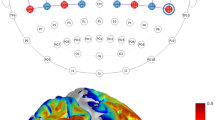Abstract
Near-infrared spectroscopy (NIRS) is a non-invasive optical technique that can be used for brain–computer interfaces (BCIs) systems. A common challenge for BCIs is a stable and reliable classification of single-trial data, especially for cognitive (mental) tasks. With antagonistic activation pattern, recently found for mental arithmetic (MA) tasks, an improved online classification for optical BCIs using MA should become possible. For this investigation, we used the data of a previous study where we found antagonistic activation patterns (focal bilateral increase of [oxy-Hb] in the dorsolateral prefrontal cortex in parallel with a [oxy-Hb] decrease in the medial area of the anterior prefrontal cortex) in eight subjects. We used the [oxy-Hb] responses to search for the best antagonistic feature combination and compared it to individual features from the same regions. In addition, we investigated the use of antagonistic [deoxy-Hb], total hemoglobin [Hbtot] and pairs of [oxy-Hb] and [deoxy-Hb] features as well as the existence of a group-related feature set. Our results indicate that the use of the antagonistic [oxy-Hb] features significantly increases the classification accuracy from 63.3 to 79.7%. These results support the hypothesis that antagonistic hemodynamic response patterns are a suitable control strategy for optical BCI, and that only two prefrontal NIRS channels are needed for good performance.

Similar content being viewed by others
References
Bauernfeind G, Leeb R, Wriessnegger SC, Pfurtscheller G (2008) Development, set-up and first results for a one-channel near-infrared spectroscopy system. Biomed Technol 53:36–43
Coyle SM, Ward TE, Markham CM (2007) Brain–computer interface using a simplified functional near-infrared spectroscopy system. J Neural Eng 4:219–226
Coyle SM, Ward T, Markham CM, McDarby G (2004) On the suitability of near-infrared systems for next generation brain computer interfaces. Physiol Meas 25:815–822
Ehrsson HH, Geyer S, Naito E (2003) Imagery of voluntary movement of fingers, toes, and tongue activates corresponding body-part-specific motor representations. J Neurophysiol 90:3304–3316
Franceschini MA, Fantini S, Thompson JH, Culver JP, Boas DA (2003) Hemodynamic evoked response of the sensorimotor cortex measured noninvasively with near-infrared optical imaging. Psychophysiol 40:548–560
Gratton G, Fabiani M (2001) Shedding light on brain function: the event-related optical signal. Trends Cogn Sci 5(8):357–363
Herrmann MJ, Ehlis AC, Wagener A, Jacob CP, Fallgatter AJ (2005) Near-infrared optical topography to assess activation of the parietal cortex during a visuo-spatial task. Neuropsychologia 43:1713–20
Herrmann MJ, Huter T, Plichta MM, Ehlis AC, Alpers GW, Mühlberger A, Fallgatter AJ (2008) Enhancement of activity of the primary visual cortex during processing of emotional stimuli as measured with event-related functional near-infrared spectroscopy and event-related potentials. Hum Brain Mapp 29:28–35
Hock C, Müller-Spahn F, Schuh-Hofer S, Hofmann M, Dirnagl U, Villringer A (1995) Age dependency of changes in cerebral hemoglobin oxygenation during brain activation: a near-infrared spectroscopy study. J Cereb Blood Flow Metab 15(6):1103–1108
Hofmann MJ, Herrmann MJ, Dan I, Obrig H, Conrad M, Kuchinke L, Jacobs AM, Fallgatter AJ (2008) Differential activation of frontal and parietal regions during visual word recognition: an optical topography study. Neuroimage 40:1340–1349
Hummel F, Saur R, Lasogga S, Plewnia C, Erb M, Wildgruber D, Grodd W, Gerloff C (2004) To act or not to act. Neural correlates of executive control of learned motor behavior. Neuroimage 23(4):1391–1401
Kato T (2004) Principle and technique of NIRS-Imaging for human brain FORCE: fast-oxygen response in capillary event. Int Cong Ser 1270:85–90
Maki A, Yamashita Y, Ito Y, Watanabe E, Mayanagi Y, Koizumi H (1995) Spatial and temporal analysis of human motor activity using noninvasive NIR topography. Med Phys 22(12):1997–2005
Müller-Putz GR, Scherer R, Brunner C, Leeb R, Pfurtscheller G (2008) Better than random? A closer look on BCI results. Int J Bioelectromagn 10:52–55
Naito M, Michioka Y, Ozawa K, Ito Y, Kiguchi M, Kanazawa T (2007) A communication means for totally locked-in ALS patients based on changes in cerebral blood volume measured with near-infrared light. IEICE Trans Inf Syst E 90(D):1028–1037
Pfurtscheller G, Allison BZ, Bauernfeind G, Brunner C, Solis Escalante T, Scherer R, Zander TO, Mueller-Putz G, Neuper C, Birbaumer N (2010) The hybrid BCI. Front Neurosci 4:42
Pfurtscheller G, Bauernfeind G, Wriessnegger SC, Neuper C (2010) Focal frontal (de)oxyhemoglobin responses during simple arithmetic. Int J Psychophysiol 76:186–192
Pfurtscheller G, Brunner C, Schlögl A, Lopes da Silva FH (2006) Mu rhythm (de)synchronization and EEG single-trial classification of different motor imagery tasks. Neuroimage 31:153–159
Pfurtscheller G, Neuper C (1994) Event-related synchronization of mu rhythmin the EEG over the cortical hand area in man. Neurosci Lett 174:93–96
Sagara K, Kido , Ozawa K (2009) Portable single-channel NIRS-based BMI system for motor disabilities’ communication tools. Conf Proc IEEE Eng Med Biol Soc 602–605
Singh A K, Okamoto M, Dan H, Jurcak V, Dan I (2005) Spatial registration of multichannel multi-subject fNIRS data to MNI space without MRI. Neuroimage 27:842–841
Sitaram R, Zhang H, Guan C, Thulasidas M, Hoshi Y, Ishikawa A, Shimizu K, Birbaumer N (2007) Temporal classification of multichannel near-infrared spectroscopy signals of motor imagery for developing a brain-computer interface. Neuroimage 34:1416–1427
Suffczynski P, Pijn JP, Pfurtscheller G, Lopes da Silva FH (1999) Event-related dynamics of alpha band rhythm: a neuronal network model of focal ERD/surrounded ERS. In: Pfurtscheller G, Lopes da Silva FH (eds) Handbook of electroencephalography and clinical neurophysiology, revised edition vol VI, Elsevier, Amsterdam, pp 67–85
Wolf M, Wolf U, Choi JH, Gupta R, Safonova LP, Paunescu LA, Michalos A, Gratton E (2002) Functional frequency-domain near-infrared spectroscopy detects fast neuronal signal in the motor cortex. Neuroimage 17(4):1868–1875
Wriessnegger SC, Kurzmann J, Neuper C (2008) Spatio-temporal differences in brain oxygenation between movement execution and imagery: a multichannel nearinfrared spectroscopy study. Int J Psychophysiol 67:54–63
Acknowledgment
The authors’ BCI research has been supported by the EU project PRESENCCIA (IST-2006-27731), "Land Steiermark" (project A3-22. N-13/2009-8), and the Neuro Center Styria (NCS) in Graz, Austria.
Author information
Authors and Affiliations
Corresponding author
Rights and permissions
About this article
Cite this article
Bauernfeind, G., Scherer, R., Pfurtscheller, G. et al. Single-trial classification of antagonistic oxyhemoglobin responses during mental arithmetic. Med Biol Eng Comput 49, 979–984 (2011). https://doi.org/10.1007/s11517-011-0792-5
Received:
Accepted:
Published:
Issue Date:
DOI: https://doi.org/10.1007/s11517-011-0792-5




